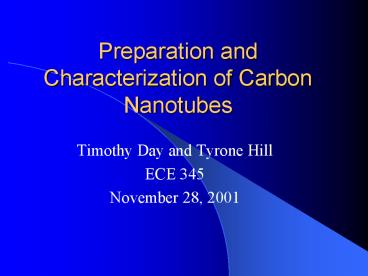Preparation and Characterization of Carbon Nanotubes - PowerPoint PPT Presentation
1 / 35
Title:
Preparation and Characterization of Carbon Nanotubes
Description:
Dr. Joe Lyding for guidance and use of his facilities. Frankie Liu and Nathan Guisinger for their help and technical expertise ... – PowerPoint PPT presentation
Number of Views:1099
Avg rating:3.0/5.0
Title: Preparation and Characterization of Carbon Nanotubes
1
Preparation and Characterization of Carbon
Nanotubes
- Timothy Day and Tyrone Hill
- ECE 345
- November 28, 2001
2
Overview
- Objectives
- Background Information
- Original Design
- Successes and Challenges
- Testing
- Conclusions
3
Project Goals
- Objective To perfect a process for creating
H-passivated Si 100 wafers with a sparse enough
CNT density to allow manipulation and
characterization with an STM. - 5 nanotubes/square ?m
4
Project Features and Equipment
- Characterization of CNT bonding with Si
H-passivated layer - Knowledge of CNT electrical properties
- Recipe for preparing CNT deposition
- UHV Chamber
- Atomic Force Microscope
- Scanning Electron Microscope
- Scanning Tunneling Microscope
5
CNT Background Info
- Discovered by S. Ijima in 1991
- Tubular hexagonal arrays of graphene sheets
- Can be single-walled or multi-walled (2 nm SWNT
diameter) - Have metallic or semiconducting properties
- Nanoelectronic Applications
6
CNT Background Info
- Chiral vector
- Ch aV1 bV2
- Metallic
- ab
- Semi-conducting
- (a-b)3N
- Types
- Armchair (a,a)
- Zigzag (a,0)
- Chiral (a,b) angle gt 30
7
Original Design
- Degrease Wafers
- UHV Passivation
- Deposition of CNT
- STM/AFM Characterization
- Deposit Metal Contacts
- Electrical Characterization
C60
8
Ultra High Vacuum System
- Main Chamber- Ion Pump w/ base pressure 5
10-11 Torr - Scanning Tunneling Microscope Chamber off main
chamber designed by Dr. Lyding - Bake- 300 C for 7 days
- Estimated Cost 300,000
9
Ultra High Vacuum System
DipStick
Main Chamber
Manipulator
STM
Load-Lock
10
Ultra High Vacuum Chamber Basic Operation
- Proper Handling of Samples and Sample Holders
- Procedure for Inserting Samples into Chamber
using load-lock - Maneuvering of Sample Holder with Dipstick and
Manipulators
11
UHV Passivation
- Degas Si sample (700 C, 24 hrs)
- Cool Dipstick to 40ºC/Perform temperature
calibration with pyrometer - Passivation temp 377 C
- Expose Si to two 30 second heat flashes
- Introduce H2 gas
12
UHV Passivation
- Step 1 Diatomic Hydrogen (H2) is introduced into
the chamber - Step 2 The tungsten cracking filament breaks
the H bonds - Step 3 The atomic hydrogen atoms attach to the
dangling bond on the Si surface
13
H-Passivation
- Dimer rows
- Si Terraces
- Si Defects
- Dangling Bonds
14
Adjustments and New Directions
- Began using wet H-passivation
- 501 HF dip for 30 seconds, DI for 15 seconds,
blow dry with N2 gas - Concentrated on CNT deposition
- Made 110 dilution and 1100 dilution of original
CNT solution - Deposited using volume-controlled syringe
- Atomic Force Microscope
15
Atomic Force Microscope
- Two modes Contact Tapping
- Tip diameter used was 5-10 nm
- Diameter will affect spreading effects
- Atomic Resolution
- Small Damage Effects
- Slow Scanning Speed
16
Atomic Force Microscopy
- 1. Laser
- 2. Mirror
- 3. Photodetector
- 4. Amplifier
- 5. Register
- 6. Sample
- 7. Probe
- 8. Cantilever
17
AFM Lateral Distortion
18
AFM Images of Si(100) after Deposition of CNT
Solution
19
AFM Images of Si(100) after Deposition of CNT
Solution
20
Environmental Scanning Electron Microscopy
- Column generates electron beam that is aimed at
sample and focused with EM fields - Images are obtained by detecting and processing
primary electron scattering - Resolution of 5-10 nm
- Scanning speed faster than AFM
21
ESEM Micrographs of CNT Ropes on Si(100)
22
Problems and Solutions
- CNTs appeared only in concentrated islands
- Amorphous carbon particles contaminated CNT
islands - Made new CNT solution
- Anthony Bollinger, Physics Dept. UIUC
- Dried CNT in DCE
- Sonicated for 15 min
23
ESEM Micrographs of Diluted CNT Ropes on Si(100)
24
Conclusions from ESEM
- Use second CNT solution with 15 dilution
- Sonicate diluted solution for at least 15 min
- Deposit 2 ?L drop and allow solvent(DCE) to
evaporate - Scanning Tunneling Microscopy
25
Scanning Tunneling Microscopy
- A biased sharp tip at nm distances causes a
tunneling current to flow between sample and tip - Feedback of tunneling current keeps current
constant while varying height of tip using a
voltage controlled piezoelectric tube - Movements are recorded and converted to
topographical map of sample surface
26
UHV STM Design
Piezoelectric Scanning Unit
Tunneling Probe
Sample Holder
27
Image After Sample Degas
3000x3000 Å2 -3.5V 4x10-11A
Large rope like structure present, as well as,
the atomic steps of silicon surface are observed.
28
Image of Rope Section
Initial Image of Bundle Tip is Multiple
After Several Scans Bundle Appears to be
Unraveling
600x600 Å2 -3.5V 3.25x10-11A
600x600 Å2 -3.5V 3.25x10-11A
29
Single Walled Nanotube on Passivated Si(100)
800x800 Å2 -3.5V 4x10-11A
25Å
30
Magnified SWNT and DOS Characterization
Topography
dI/dV
300x300 Å2 -3.5V 8.6x10-12A
31
Multiple Tip Image of Potential Single Wall
Nanotube
650x650 Å2 -3.5V 4x10-12A
17Å
Attempted to damage tube using nano- lithography
routine, tube was clearly perturbed, but more
work is needed before we can draw any
conclusions.
32
Zoom in of Multiple Tip Image of Potential Single
Wall Nanotube
450x450 Å2 -3.5V 4x10-12A
33
Final Conclusions
- Possible to image CNTs with STM on semiconducting
substrate - Van der Waals interactions make isolation of
single tube very difficult - Could get better data with sharper STM tip
- Use cleaner solvent to avoid organic contamination
34
Special Thanks
- Dr. Joe Lyding for guidance and use of his
facilities - Frankie Liu and Nathan Guisinger for their help
and technical expertise - Anthony Bollinger for his CNTs
- Matt Olson for his advice
35
Questions?































